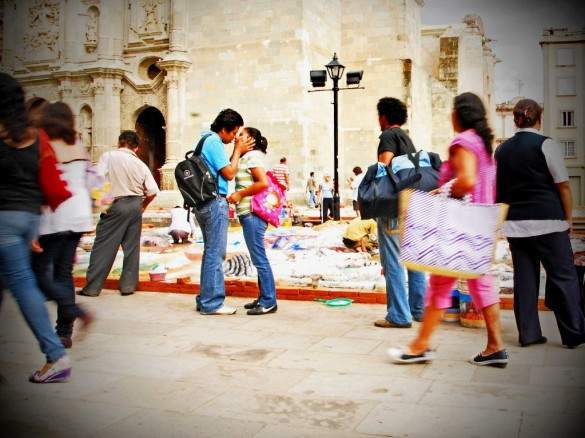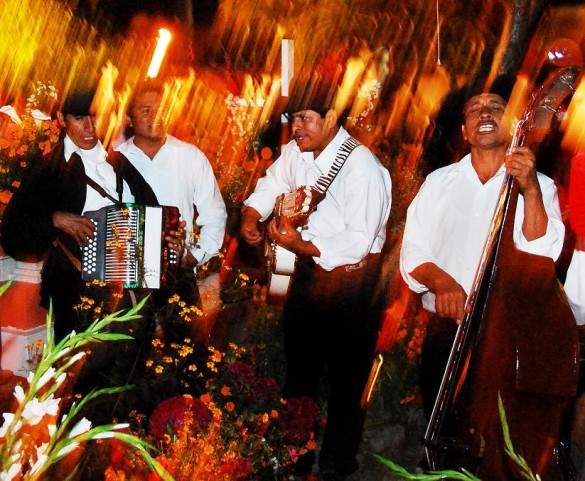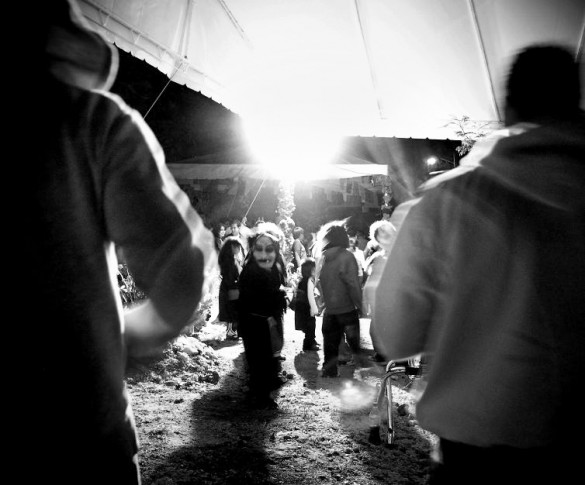Considered sacrilegious by Spanish Conquistadors, the tradition known today as Dia de los Muertos, or Day of the Dead, survived despite the Spaniards attempts to destroy the Mesoamerican ritual, which celebrates death as the wakening of one’s soul.
Nearly 500 years later, the traditional observance of Dia de los Muertos continues throughout Mexico. Unlike the scare-filled Halloween rituals of America, Day of the Dead festivals, which take place from Oct. 31 to Nov. 2, are merry occasions more akin to Mardi Gras in New Orleans. During the celebration, it’s believed deceased relatives, both young and old, return to the mortal world to take part in the festival, enjoy earthly treats and visit with loved ones. And while Dia de los Muertos can be experienced throughout Mexico, one of the most colorful places to enjoy the festival is in Oaxaca.
Located in southern Mexico, the city of Oaxaca is filled with music, the smell of fresh flowers, in particular marigolds, and an overall exuberance during El Dia de los Muertos. Throughout the festival’s three days, marching bands roam through the Spanish-colonial city invoking impromptu parades that culminate in the plaza surrounding the town’s center known as the Zocalo. On the eastern edge of town is the city’s municipal cemetery, Panteon General de San Miguel, which holds its Day of the Dead vigil on Nov.1. Additionally, there are also two other rural towns—Xoxocotlan and San Felipe, both a short cab ride from the Zocalo— that hold festival vigils on Oct. 31 and Nov. 2, respectively, in their cemeteries.

Artists, mainly students from Oaxaca‘s Instituto de Artes Graficas, volunteer each year to construct colorful sand murals known as Tapete in the Plaza Santo Domingo.

Pablo Parra-Meixieiro lets his hands do the talking. The then 34-year-old painter said the white substance covering his, and the other artists hands, was a calcium, lime mixture, which is used along with other colored pigments to make the murals pop from the concrete plaza.

Every year the city of Oaxaca enlists a “master” to design a unique Tapete, Parra-Miexeirio explained. For the 2009 mural, he said the “master” resided from Japan, and that it generally takes approximately three days to complete with the culmination coming on Nov. 2, the day the souls of the departed return to earth.

Like the Zocalo, the plaza in front of the Church and former Monastery of Santo Domingo de Guzman is great place to people watch or capture street photos. Set in the shadow of the cathedral the wide plaza area bustles with street merchants and lovers of all ages.
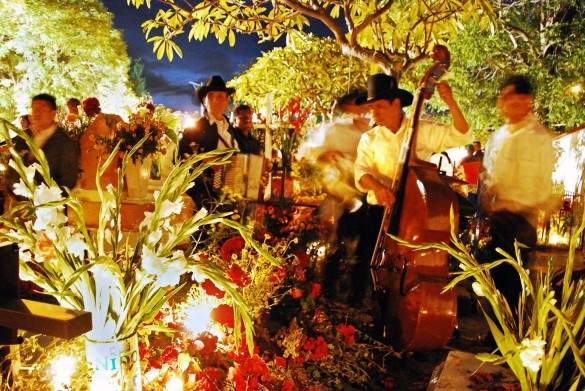
Music is an integral part of the Dia de los Muertos festival. Marching bands and mariachi musicians are paid by citizens to serenade their family’s gravesite. The result is a kaleidoscope of sound that reverberates throughout the cemetery keeping the atmosphere lively.
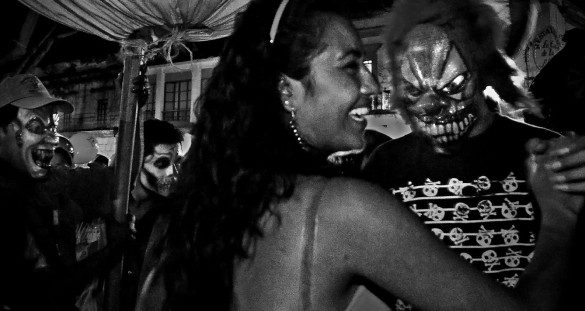
Masked men and women dance in the street to the Mixtec jazz that blows from the brass bands, which snake through the cobblestone corridors of the city, while young goblins do their best to scare up some treats.
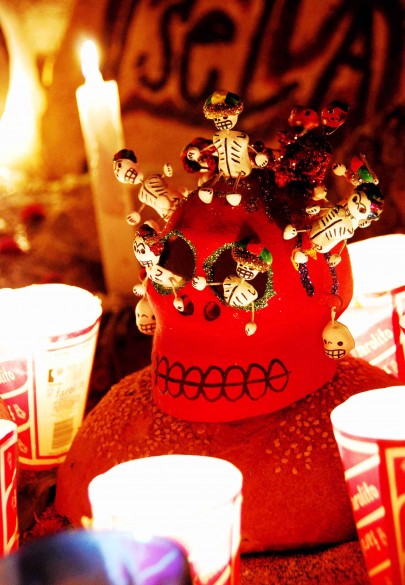
Playful skulls and skeletons, wooden and sugar alike, are a plentiful sight in Oaxaca during the Day of the Dead celebrations. Parra-Meixieiro explained the use of the comical skeletons dates back to the Mexican Revolution when illustrators, like Jose Guadalupe Posada, used the skeletons, which escaped repression by the government, to convey political issues.
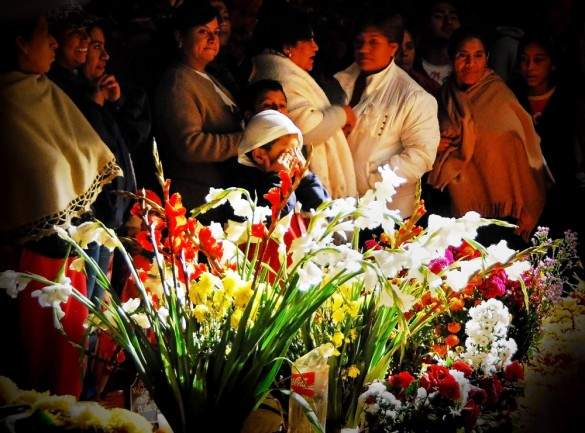
A boy weeps in front of his family at San Felipe Cemetery. Whether you visit the city’s Panteon General de San Miguel or one of the rural cemeteries, the lush displays of flowers, including marigolds and lilies, placed on the graves create a vivaciously warm atmosphere that even on the darkest of nights fill the cemeteries with life.
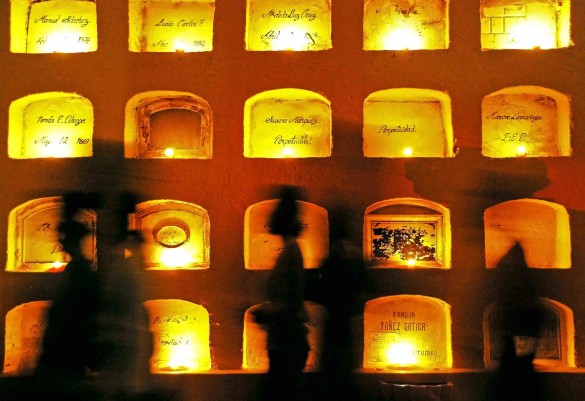
On Nov. 1, the 2,400 niches located in the perimeter wall that surround Panteon General de San Miguel are illuminated by candlelight. Though, it should be noted that unlike the rural cemeteries, many of the family members do not hold lengthy vigils at the gravesites in the city’s municipal cemetery.
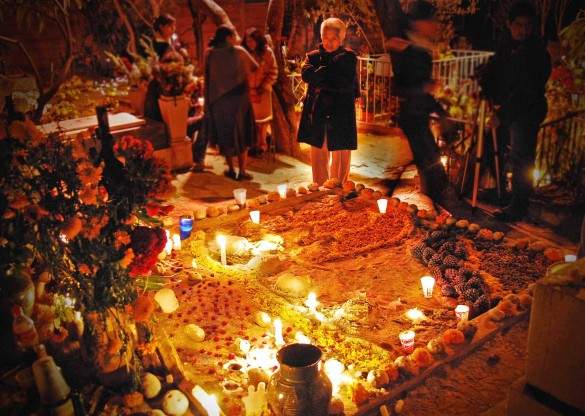
A woman admires Julia Chen’s family’s gravesite in San Felipe Cemetery. Chen, who lost her newborn and later her boyfriend, said, “We try hard to do a little something different. All of the designs include the taste of our family.” For example, Chen explained seashells were used in her family’s display because her sister-and-law liked the ocean.
Randy Kalp is a semi-intrepid journalist traveling the world and missing his 7-pound hound. His work appears regularly in the Coast News, San Diego Reader and a variety of other travel publications. Bethany Salvon is a professional photographer and travel junkie. Her favorite food is the blueberry and she never wants to be eaten by an alligator. She has a B.F.A in Photography, has worked as a commercial photographer and has been photographing weddings for over 9 years. They can be found at their budget travel site Beers and Beans. Bethany can also be found on her professional photography site Nariko’s Nest.com.




